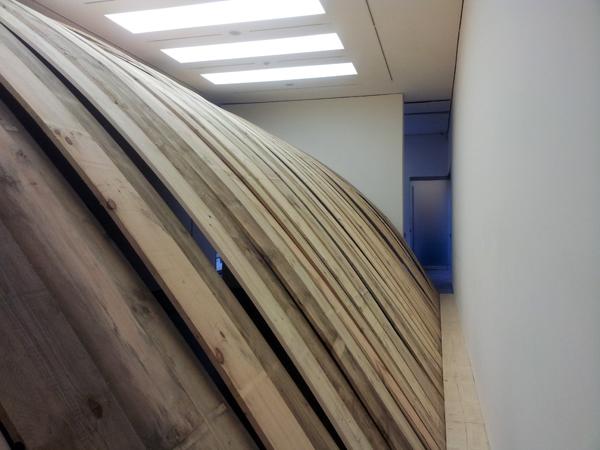White Cube Mason’s Yard presents the first UK exhibition of new work by American artist Virginia Overton. For this exhibition Overton has worked with the gallery space, creating new, site-specific works using locally sourced, recycled materials, which are then turned into sculpture and installation that is a direct response to the space.
The artist’s practice is a journey of trial and error whereby works are mostly created site-specifically as a direct response. Overton uses materials more commonly associated with building or construction, such as wood, metal, fluorescent lighting, mirrored acrylic, lumber, rope and cement; as well as appropriated ready-mades such as sandbags, chairs, ladders or pipes, are used to bisect space,and subvert the dynamics of architectural space’s layout and flow.
The ground floor gallery of Mason’s yard has been transformed through the installation of planks of whitewood which flex against the gallery walls. The wood is held in place by its own tension, creating a precarious bow where it reaches the ceiling. Through this bending and stretching the sculpture breaks the linearity of the surrounding architecture, manipulating the space and the viewers movements.
In the lower ground floor gallery there are three open-ended rectangular wooden boxes are suspended from the ceiling by single looped lifting straps suggesting heavy weight, the three forms constitute a constantly shifting cluster of objects, like a giant hanging mobile. These long boxes, made with the remaining whitewood from the ground floor installation, encourage the viewer to pause to experience the works slow movement. The oblong boxes interact with each other, slowly shifting and swinging. The slow kinetic action of the work serves to highlight its weight and balance, the principles of physics hidden within the ‘artistic’. The Renaissance balance of mathematics and art.
A third sculpture is to be found tucked away in the adjacent corner of the lower ground floor which is also made from whitewood, that has been interwoven and stacked together. Unfolding and extending from the corner of the space, the planks of whitewood are subtly flexed within the interlaced stack as if at any moment the tension and trapped energy will be released and the sculpture radically change form.
The artist’s work has a minimal principle employing materials without alteration, there is a simplistic honest rawness to Overton’s work. The artist adapts her materials to the space at hand, with a juxtaposition between ‘ a truth to materials’ and the interaction with, in this case, the white-cube space. Overton has created large-scale sculptures and installations that focus on volume, and the inherent physicality of their component parts. The artist’s objects discuss weight, and the tension formed between the materials used, and the chosen installation space.
These works have a simplicity relating to pure language – the language of sculpture – there is nothing disguised or hidden by the artist. Every component part is pre-existing, whether it be a plank of wood, or a branded lifting strap. The objects are finished forms from the world, and unfinished materials within Overton’s works. The idea of the ready-made as a component part to the minimalistic purity of sculptural language is inherent in the artist’s practice.
This may all sound a little dull, possibly overly simplistic in this age of image saturation and complicated works by 21st century visual artists, but in fact Overton’s work is an important reminder. The installations employ the very foundations of sculptural language laid bare.
This is a show for the next generation of graduates to pay attention to: for whatever the work may be comprised of, no matter how complex the form, the foundations must be of stone, not sand. In any truly successful work of art lies an inherent understanding of language. In this instance the artist employs a purity of sculptural language, the tools may indeed be obvious, but the resulting juxtaposition is one of minimalist poetry – and a reminder that the artists understanding is the very foundation of success.
Virginia Overton – White Cube Mason’s Yard – until 14 March 2015
Words: Paul Black Photo: P A Black © Artlyst 2015 all rights reserved

